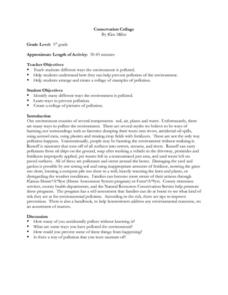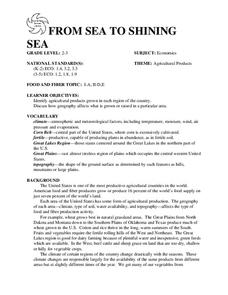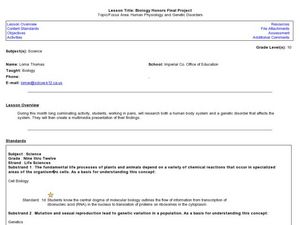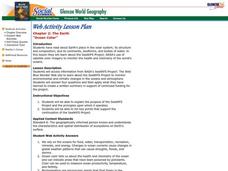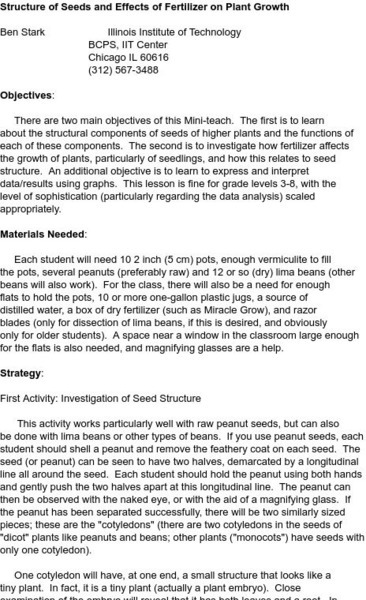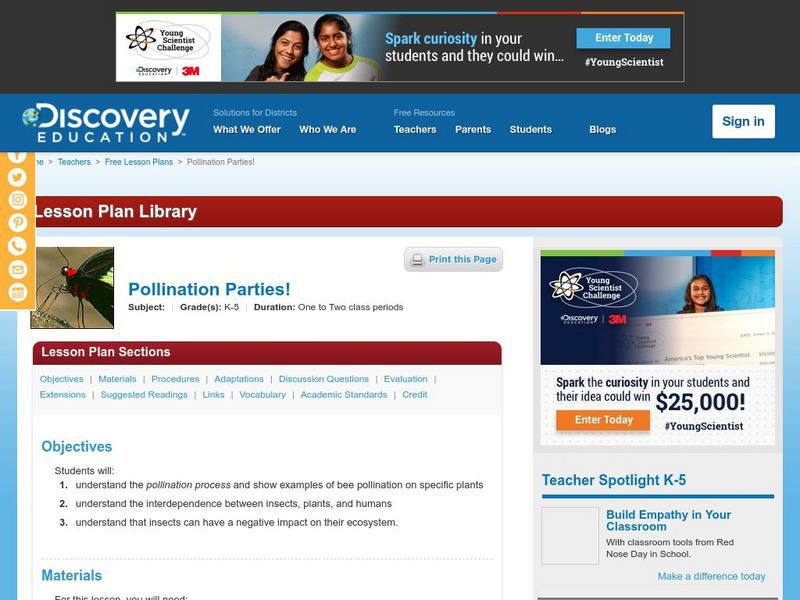Curated OER
Conservation Collage
Students identify many different ways the environment is polluted, and determine ways to prevent pollution. They create a collage of pictures describing how the earth becomes polluted.
Curated OER
Water Quality and Nitrates & Phosphates
Students examine the effects of nitrates and phosphates on the dissolved oxygen levels in different water sources. For this series of 3 lessons, they consider the reasons for nitrate and phosphate level increases and their effects on...
Curated OER
FROM SEA TO SHINING SEA
Identify agricultural products grown in each region of the country.
Discuss how geography affects what is grown or raised in a particular area.1. Hand out a copy of the two activity sheets "Food From Sea to Shining Sea" to each student....
Curated OER
What Are We?
Students describe different types of water pollutants. They complete experiments in which they observe the affects of water pollution on algae. They also brainstorm and list three causes of each water pollutant.
Curated OER
Vegetable Twister
Students review vegetables and their nutrient values and production. In this vegetable production worksheet, students read information about the nutrients in vegetables and how they are grown. Students participate in a game of Twister to...
Curated OER
Archaeobotany
Pupils study pictures of seeds and the conditions in which they grow during their study of archaeobotany. They infer ancient plant use by looking at archaeobotanical samples. They determine the change of plant use by interpreting a graph...
Curated OER
LISTENING TO DIRECTIONS
Students view farm objects or products made from farm animals and follow the oral instructions given by the teacher. They are given worksheets, there are three sets of directions for the one worksheet. Students worksheets have everything...
Curated OER
Biology Honors Final Project
Tenth graders work on a project about cellular biology and genetics. In this biology lesson, 10th graders research about the assigned human body system and genetic disorders that affect it. They create a multimedia presentation and...
Curated OER
Punnett Squares/Genetics
Ninth graders complete a monohybrid cross and a dihybrid cross. In this biology lesson, 9th graders predict the traits of offspring using the Punnett square. They differentiate recessive and dominant genes.
Curated OER
Ocean Color
Learners examine NASA's SeaWiFS Project Web site to explore how the SeaWiFS Project monitors environmental and climatic changes in the oceans and atmosphere. They answer questions and write a summary in support of continued funding for...
Curated OER
Bat Facts
Student's demonstrate an understanding of basic facts about bats by creating a picture representation of bats in their habitat describing information they learned. The lesson is especially favorable for visual learners.
Curated OER
Exploring Bats
Third graders create a graphic organizer about bats in cooperative groups. The graphic organizer is used to illustrate the information that has been researched. The specific graphic organizer is the KWL.
Curated OER
Clean Kansas Water
Students gain an understanding of ways we can be responsible custodians of our water supply. Students explore the governor's clean water initiative involving the Lower Kansas/Republican river basin and the pollutants present there.
Curated OER
Iconography: Art and Literature
Students discover the main subjects and objects of Buddhist art and how symbolism in the Arts can enhance the artistic elements. The lesson concludes with the creation of student works using iconography.
Curated OER
Turn On A Light And Do Your Own Revegetation
Students use electricity and plant a seed to observe the process when coal is the major fuel source to produce electricity. They use the packet of native seeds to experiment with revegetation.
Curated OER
Finding Coal Products in Your Home
Students identify items in their homes that come from coal. They divide into groups and decide as a group which items are made from coal by-products. They then divide their poster board into three columns and label the first - items made...
Curated OER
Think Green
Students experience and practice compositing and recycling through hands-on-activities. They distinguish between which items from their trash can be recycled, composted and reused. The process for making recycled paper is also covered in...
Curated OER
Planet of Plenty
Students examine a small piece of land to determine the diversity of life on Earth. They role play as visitors from outer space seeing life on Earth for the first time. They measure and observe their plots while working in small groups....
Other
The Plant Cell: Teaching Tools in Plant Biology: Why Study Plants?
Plants are essential for all life and development. Teach your students about this incredible lifeforce with this teaching guide, lecture notes, and PowerPoint presentation. [PDF]
Science and Mathematics Initiative for Learning Enhancement (SMILE)
Smile: Structure of Seeds and Effects of Fertilizer on Plants
In this lesson plan, students identify parts of seeds and the effect of fertilizer on their germination and development.
Science & Plants for Schools
Science & Plants for Schools: Pollination, Fertilization, Fruits [Pdf]
Great PDF to teach students about plant reproduction and life cycle. There are many teacher printables.
Science Education Resource Center at Carleton College
Serc: Duckweed Bioassay
This lab was designed with the intent to mimic the effect fertilizers can have on plants in a lake or pond ecosystem. Students determine the effect different fertilizer concentrations have on the growth rate of duckweed plants, as...
Science Education Resource Center at Carleton College
Serc: Investigating the Difference in Geology
In this inquiry based field investigation, students will be observing our school campus's topography, soil, and plants and comparing them with the Fertile sand dunes' topography, soil, and plants. They will make detailed observations and...
Discovery Education
Discovery Education: Pollination Parties
This lesson helps students understand the concept of pollination. Objectives, materials, procedures, adaptations, discussion questions, evaluation, extensions, suggested readings, links, vocabulary, and academic standards are all included!
